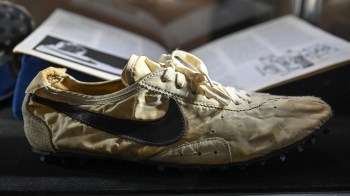A comeback for sales of fine art
TEXT OF INTERVIEW
Kai Ryssdal: I’m no expert in fine art, but I know a comeback when I see it. Art is definitely having one. First there were solid impressionist and modern auctions two weeks ago. Then, this past Tuesday and Wednesday, contemporary pieces did quite nicely. Monday, on the broadcast, we talked to art advisor Richard Polsky about what to expect as those sales got going at Sotheby’s and Christie’s. We’ve got him back now for the after action report.
Richard, good to talk to you again.
Richard Polsky: Hey, nice to be here.
Ryssdal: So, first things first. Tell us about your client — had a painting in the Sotheby’s auction. How did it do?
Polsky: It was a little touch-and-go at first. The night of the sale, at six o’ clock — the auction was at seven — I get sort of a desperate phone call from one of the auction house personnel for Sotheby’s. The painting I was involved with was an artist named Joan Mitchell. And in this case, the reserve was $800,000.
So the person from Sotheby’s says, “Look, we’re a little nervous about the sale. There are two other Joan Mitchells coming up before yours. Let’s lower the reserve to 750.”
And I’m going, “Oh no.” And I said, “Do you think it’s not going to sell?”
And he says, “No no no, I think it’ll do fine. But let’s play it safe. Let’s get the audience sucked in, let’s get the bidding going. Let’s pump ’em up.”
And I go, “Look, I have to clear this with my client.”
So fortunately I was able to find her and she comes up to me, after I had explained to her what the deal was on the cellphone and whispers in my ear, “No.”
OK, so the auction gets under way. The Mitchell I’m involved with comes up. They start the bidding at $600,000. And at 750, you know, the next bid is the money bid.
Ryssdal: Right.
Polsky: I’m waiting and I’m waiting and I’m going, “Oh God, it’s not going to sell.” Sure enough though, a paddle goes up.
Ryssdal: What was the number at the end?
Polsky: A million-one. What a relief!
Ryssdal: When we had John on Monday, he told us about this woman who’d worked for Warhol as a teenager, got this painting as a gift, stuck it basically in her closet. Tell us what happened with that one.
Polsky: That was a beautiful moment. My God. This thing looked as fresh as the day it was painted, when it was hanging there. This is the Warhol self portrait. The estimate was a million to a million-five. With the sellers and buyers, all the premiums worked in, about $6 million.
Ryssdal: Give me a sense of what it’s like in an auction room when these paintings are going to for so much more than anybody thought. I mean, there was a Warhol, the painting of the dollar bills, it went for $43 million. What’s it like in a room when that happens?
Polsky: Well, there’s a buzz of electricity. Because you’ve got to understand, the night before at Christie’s, on Tuesday night, the sale was flat. The big ticket item was a Jean-Michel Basquiat painting with the unlikely title of “Brother Sausage.” It did not sell. So the buzzes can work the other way. When it didn’t sell, the audience is like “Oh oh” and you hear a collective groan.
The next night though, you have the antithesis, where their big ticket item was Warhol’s “200 Dollar Bills,” estimated at $8 to $12 million. They opened the bidding at six, they quickly jump it to eight and someone yells out, “Twelve!” So you knew something was going on that night. And as you might imagine, the room was just filled with this collective energy. It was like it was crackling.
Ryssdal: Let me ask you this though Richard: How do you make an art market like this matter in the wider context?
Polsky: You gotta believe when people read the story about this $43 million Warhol, it does encourage the general economy. Because people are saying “Money is being spent!” They believe there are things that will hold up, survive the test of time and continue to be valuable assets.
Ryssdal: Do you think the art market can sustain this bounce now?
Polsky: Yeah. The art market’s back; there’s no doubt about it.
Ryssdal: Richard Polsky. He’s an art advisor and also an author. His most recent book is called “I Sold Andy Warhol.” As it turns out, way “too soon,” right Richard?
Polsky: Got that right.
Ryssdal: And if you want to see the paintings we were talking about, they’re on our Web site. It’s Marketplace.org. Richard thanks a lot.
Polsky: Thanks again.
There’s a lot happening in the world. Through it all, Marketplace is here for you.
You rely on Marketplace to break down the world’s events and tell you how it affects you in a fact-based, approachable way. We rely on your financial support to keep making that possible.
Your donation today powers the independent journalism that you rely on. For just $5/month, you can help sustain Marketplace so we can keep reporting on the things that matter to you.


















